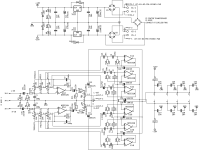Hey all. New here and still learning. I was wondering if anyone could explain to me, how one could change the value of the pots used in this schematic, to 100k versions and what affect it would have on the circuit overall?
I also see some simulators available that I might be able to use to simulate this circuit? I couldn’t seem to locate any. Thanks for any help, and if anyone has some good resources anyone could recommend to learn how this circuit works would be a huge help.
I also see some simulators available that I might be able to use to simulate this circuit? I couldn’t seem to locate any. Thanks for any help, and if anyone has some good resources anyone could recommend to learn how this circuit works would be a huge help.
Attachments
Please explain why you would change the pots?
A free simulator, widely used is available here:
https://www.analog.com/en/design-center/design-tools-and-calculators/ltspice-simulator.html
Hope this helps.
Hugo
A free simulator, widely used is available here:
https://www.analog.com/en/design-center/design-tools-and-calculators/ltspice-simulator.html
Hope this helps.
Hugo
Please explain why you would change the pots?
Hugo
I was exploring the option of using digital POTs in this circuit and as far as my somewhat limited understanding is so far, the higher end to end resistance parts have less THD figures, but I might be going at this the wrong way 😂.
The problem with scaling up to 100k is the raising of the noise-floor by 10dB. Why not stick with 10k... Yes, the THD does tend to rise at lower resistances due to stray non-linear resistances of the CMOS switches, so perhaps compromise with 20k or 50k (scaling R and C inversely as mentioned above).
The voltage noise of 10k = 13nV/√Hz, of 100k = 40nV/√Hz. The latter is well above the contribution from the opamps, even allowing for the fact a pot at mid-travel is effectively only 1/4 of the track impedance (two half-tracks in parallel).
Note that digital pots will produce audible artifacts during adjustment unless they only change value on zero-crossings. This is probably less of an issue with a tone control than a volume control since it won't be adjusted very often, but be aware of it.
For instance the AD5290 datasheet https://www.analog.com/media/en/technical-documentation/data-sheets/AD5290.pdf explains this. That device has +/-15V supplies and is intended to plug into standard opamp circuitry. It also has a suggested zero-crossing circuit in fig 35.
The voltage noise of 10k = 13nV/√Hz, of 100k = 40nV/√Hz. The latter is well above the contribution from the opamps, even allowing for the fact a pot at mid-travel is effectively only 1/4 of the track impedance (two half-tracks in parallel).
Note that digital pots will produce audible artifacts during adjustment unless they only change value on zero-crossings. This is probably less of an issue with a tone control than a volume control since it won't be adjusted very often, but be aware of it.
For instance the AD5290 datasheet https://www.analog.com/media/en/technical-documentation/data-sheets/AD5290.pdf explains this. That device has +/-15V supplies and is intended to plug into standard opamp circuitry. It also has a suggested zero-crossing circuit in fig 35.
Thanks for the detailed message. Ya I did not understand before that changing the values also changes the noise, and I did land on the ad5290 as my likely part, because it’s low noise, high voltage operation. I’m going to try to use a zero crossing circuit interrupting the MCU before sending commands, but I might filter out everything above 1khz to prevent too much interrupting.
- Home
- Source & Line
- Analog Line Level
- Changing pots in tone circuit?
